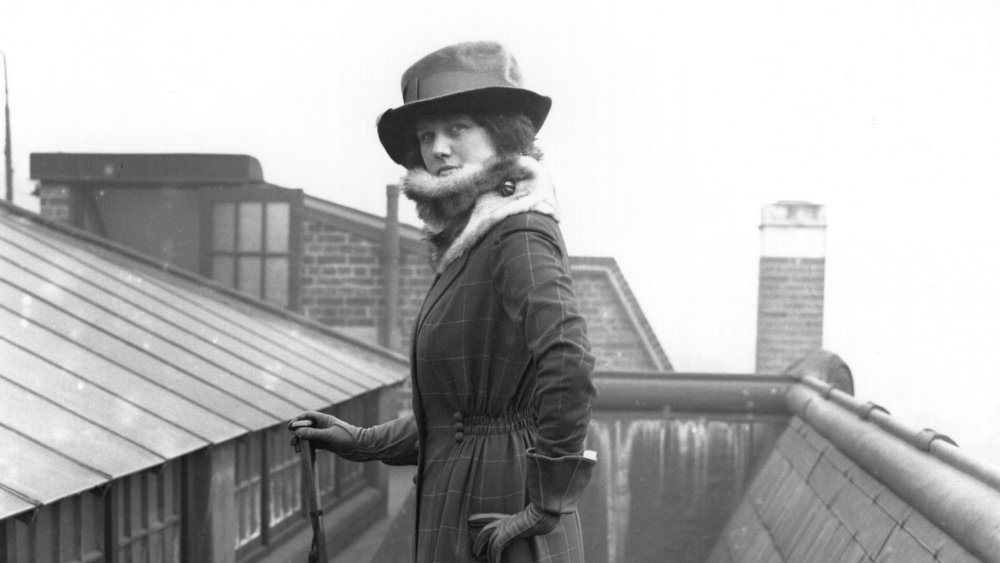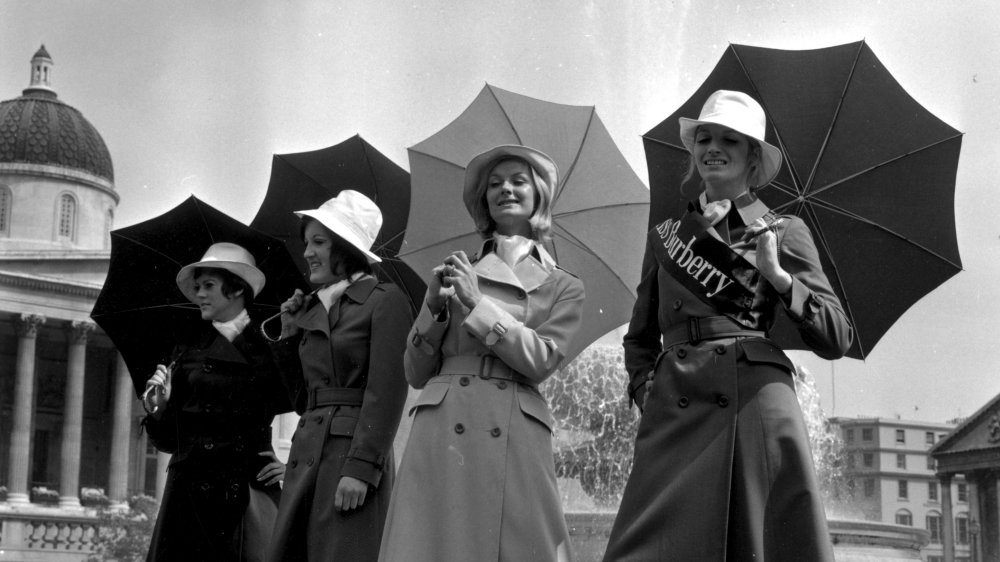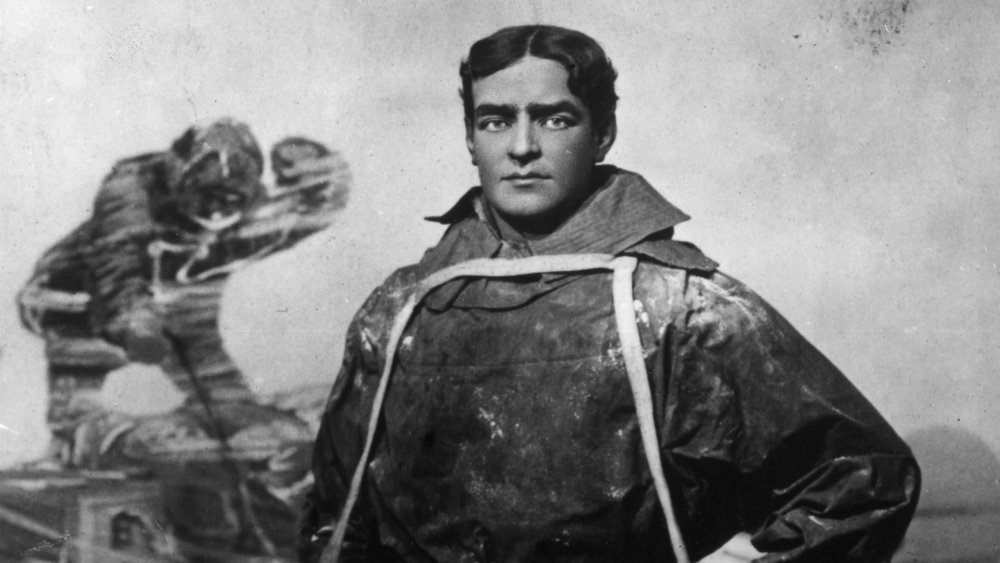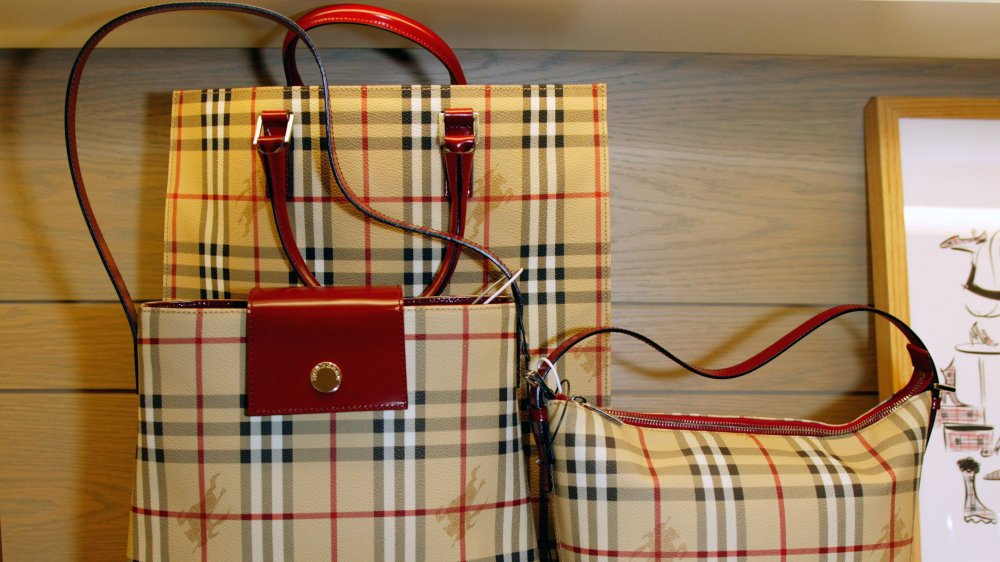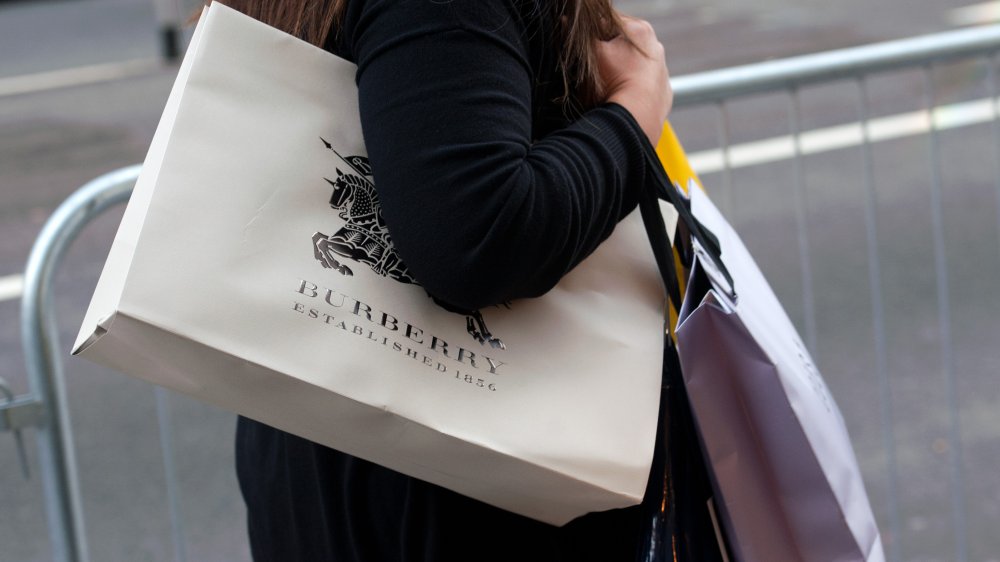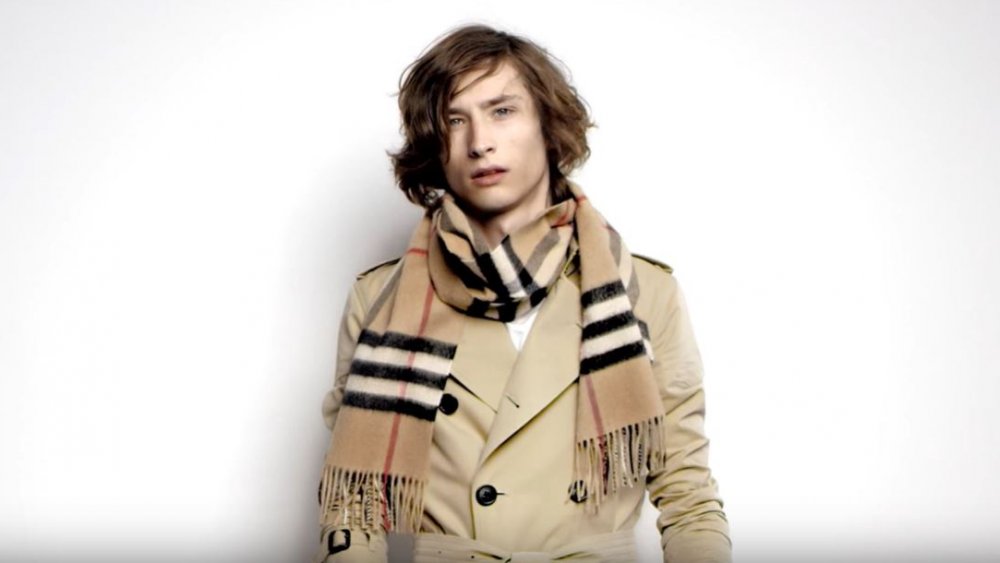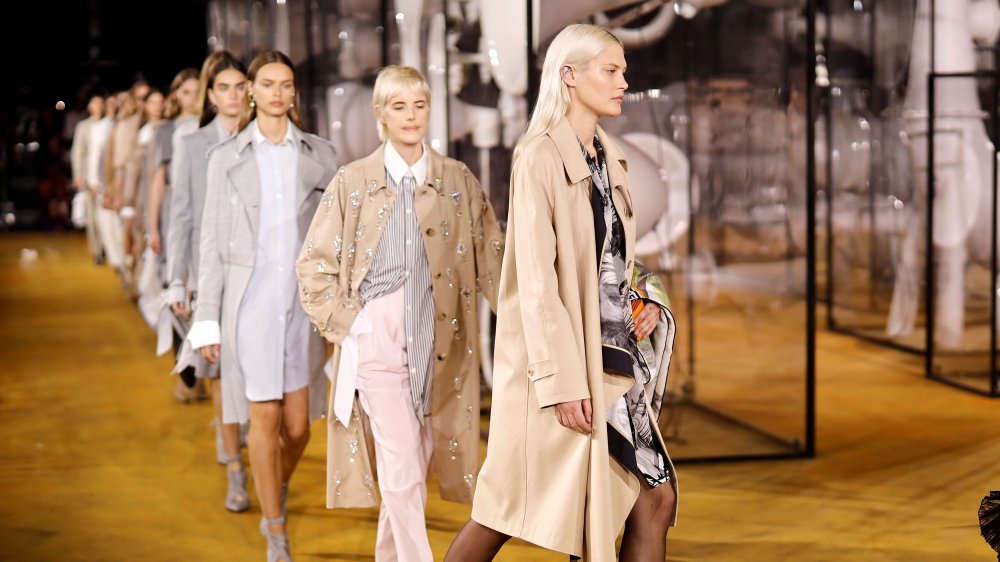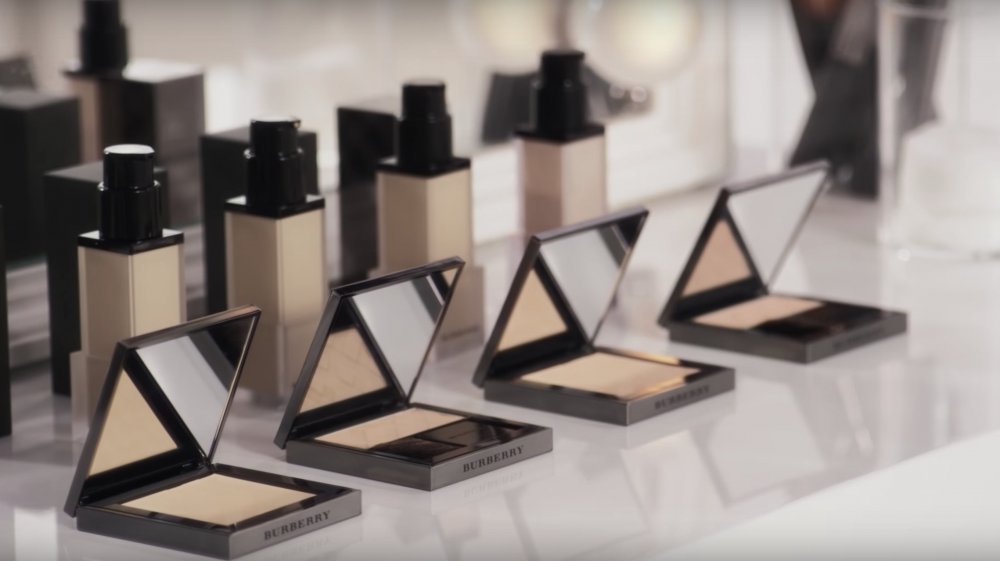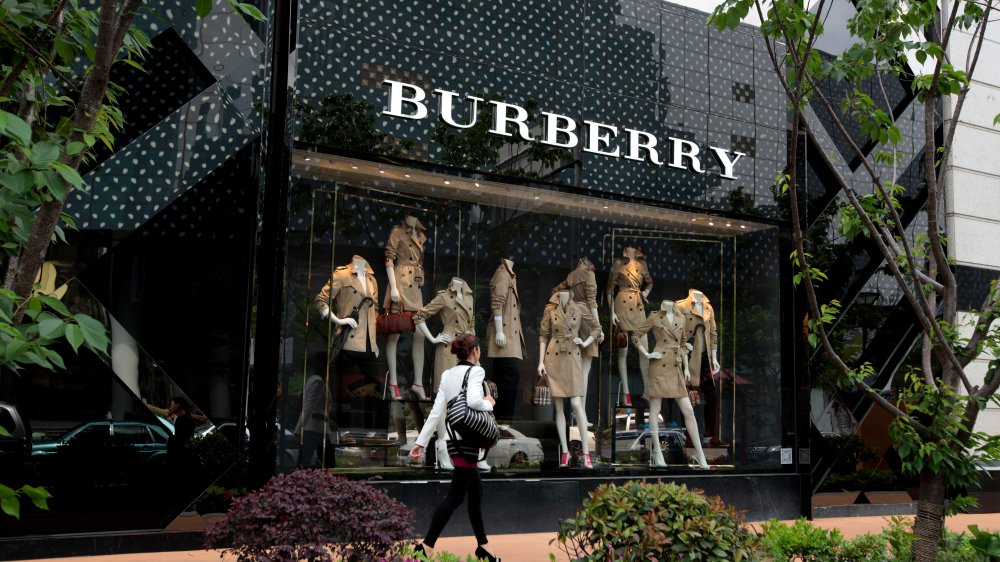The Untold Truth Of Burberry
Burberry is one of the most iconic brands of all time. It's also one of the most distinctive, thanks to its trademark check pattern that makes it instantly recognizable. The brand has defined elegance and class for decades, although its history goes back quite a bit further than most people know. Burberry wasn't always a high-status brand coveted by the working class and the wealthy alike.
Is it Burberry's long and fascinating history that makes it such a mainstay in the fashion world? Or perhaps it's that innovation has always been at the forefront of the company. Whatever the reason, it's clear that Burberry is a fashion brand that has a lot of staying power. It has evolved over the decades and has become a staple in the industry. From its humble beginnings to its current status as a powerhouse brand, here's the truth about Burberry that even its biggest fans don't know.
Burberry was founded by a 21-year-old
Perhaps one of the most impressive things about Burberry is its founder, Thomas Burberry. According to the Burberry website, Burberry was just 21 when he founded the brand that would still be an icon a century after its inception. Born in 1835 to a father who was a farmer and a grocer, as noted by History House, Burberry apprenticed with a local draper as a young man. An entrepreneur to the core, in 1857, he opened a small shop in the town of Basingstoke, England, where he could utilize not only his experience as a draper but also his knack for business.
That first shop was a humble one, and it didn't have many customers to cater to, as Basingstoke only had about 4,500 residents at that time. Nonetheless, Burberry managed to turn his outfitting business into a modestly successful one. By the time of the 1861 census, Burberry was employing seven men, seven women, and three boys in his shop. This was only the beginning for the young Burberry — bigger things were in store for the young entrepreneur.
Burberry started out selling clothing for the outdoors
Far from selling luxury goods, Burberry founder Thomas Burberry focused on outfitting people for the outdoors when he first opened his shop. According to GQ, his outdoor-ready attire was reportedly favored by historical figures like Lord Kitchener, who served as secretary of state for war in the early years of World War I, and Lord Baden Powell, a British army officer who became a national hero during the South African War.
The business model served the young Burberry well. According to History House, by the 1871 census, he had greatly increased his number of employees. The census described him as a "draper and manufacturer employing 70 hands." Burberry was doing so well that he was able to move to a home in Basingstoke with 160 acres of land, as well as hire a staff of servants to look after the estate. By the 1881 census, he had six children who were cared for by a governess. Clearly, Thomas Burberry was coming up in the business world.
Burberry invented a type of fabric
Of course, the Burberry we all know and love today sells quite a bit more than outdoor-ready attire. How did Burberry transform from a humble shop selling outdoor clothing into one of the world's leading luxury fashion lines?
It all began with gabardine. In 1879, Thomas Burberry invented the weatherproof fabric that would end up not only transforming his company, but fashion as we know it. According to The Golden Thread: How Fabric Changed History, Burberry was inspired by the way Hampshire shepherds waterproofed their smocks with lanolin.
Gabardine is made of "tightly woven, light cotton fabric." Each thread is wind and water resistant, thanks to being covered in a weatherproof coating. According to the Burberry website, rainwear before this was often "heavy and uncomfortable," but Burberry's invention of gabardine enabled him to create rain gear that wasn't just weatherproof, but also light and breathable. The fabric was patented in 1888.
Burberry pioneered the trench coat
Burberry founder Thomas Burberry's invention of gabardine not only revolutionized outerwear, but also helped the Burberry brand pioneer the trench coat as we know it today. In modern times, the Burberry trench coat is one of the brand's most enduring and iconic pieces, but the history of the trench coat dates back more than a century.
The trench coat began to gain attention as a fashion staple through its appearance in Hollywood films. According to Ethnic Dress in the United States: A Cultural Encyclopedia, screen icons like Greta Garbo and Gloria Swanson helped popularize the trench coat among moviegoers in the 1920s by wearing them in films, as did Bette Davis in the 1930s.
Burberry started advertising their women's trench coat in the 1930s, but it wouldn't be until the 1940s that the garment truly cemented its place in fashion history. Thanks to Humphrey Bogart wearing a Burberry trench coat in the 1942 movie Casablanca, which featured one of the most romantic movie scenes in history, the coat became wildly popular and has been ever since. In 1961, Audrey Hepburn famously wore one in Breakfast at Tiffany's. Further popularizing the trench coat in Hollywood was the character of Inspector Clouseau in the Pink Panther films, who wore a trench coat.
Burberry has a long military history
Before the Burberry trench coat was a fashion must-have, it was a piece of military gear. According to Ethnic Dress in the United States: A Cultural Encyclopedia, the forerunner to the trench coat was the Tielocken coat, created by Burberry in 1895. This predecessor to the modern trench coat was worn during the South African War by British generals. In 1906, the coat was officially given the seal of approval from the British War Office.
By 1914, the Tielocken coat had become standard military wear. Epaulets and D-ring belt fastenings were added. According to Smithsonian Magazine, the term "trench coat" was first seen in print in 1916, the name having been given to the coats by soldiers fighting in the trenches during World War I.
Between World War I and World War II, it evolved into a fashion staple. By World War II, the trench coat was both a fashion statement and military dress, and was worn by troops across the world. Personnel in the U.S. Army, Army Air Corps, and Marine Corps all wore trench coats during World War II.
Burberry was the brand of choice for these famous explorers
One of the things that has made Burberry such an enduring brand is its versatility. The trench coat is a look that can go from the military to the runway and not look anything but unflinchingly trendy. The brand is about more than style, though. Burberry stayed true to its roots as an outfitter for outdoor gear, making it popular with explorers like Ernest Shackleton, who wore the brand during expeditions, according to the Burberry website.
Shackleton was not the first explorer who was impressed by Burberry's weatherproof clothing. In 1893, Norwegian polar explorer Dr. Fritjof Nansen was the first explorer to bring Burberry's gabardine fabric to one of the poles when he headed to the Arctic Circle. According to the Philippine Tatler, Burberry's gabardine was also the fabric of choice for Norwegian explorer Roald Amundsen. Amundsen was the first person to make it to the South Pole, and he did so while wearing Burberry.
Another famous person to wear Burberry gabardine was aviator Claude Grahame-White, who became the first person to fly between London and Manchester in under 24 hours in 1910.
This is how the famous Burberry check pattern started off
Today, the Burberry check pattern (officially known as the Haymarket Check after the street where the first London Burberry store was opened) is arguably the brand's most iconic design. Instantly recognizable whether it's on a scarf or a handbag, the check design is a coveted status symbol. The check is a Scottish tartan design with black, red, and white accents on a beige background. The iconic design didn't come about until decades into the company's existence. According to Grailed, the pattern started off as a coat lining in the 1920s. For decades, the pattern was solely stitched into Burberry's coats.
In 1967, the Burberry scarf was born when the manager of the Paris store wanted to add some color to a display of trench coats and decided to display some with the hem facing out. The look was a hit, and people began clamoring for Burberry merchandise featuring the check pattern. The store first applied the pattern to umbrellas, which sold out right away. They then began manufacturing cashmere scarves featuring the now-iconic check. The look became popular with the British upper class and soon became a status symbol.
The iconic Burberry knight logo is laden with symbolism
The Burberry logo has quite the history. According to the Burberry website, it didn't come about until well into the company's history, first appearing around 1901. The logo, which is of an equestrian knight, features the word "prosum," which is Latin for "forwards."
According to 1000 Logos, the equestrian knight is carrying a shield "to symbolize knightly purity, honor, pride, grace, nobleness, determination, and protection."
The Burberry logo has evolved over the years. In 2018, the brand unveiled a new house logo that consisted simply of the words "Burberry London England" in an all-caps font. According to Fortune, the new logo was part of a brand revamp and was designed by graphic designer Peter Saville, whose work has included album covers for bands like Joy Division. Burberry also launched a new print that year, featuring the entwined letters "T" and "B" in honor of the brand's founder, Thomas Burberry (via GQ).
Burberry is strongly associated with British culture
GQ argues that Burberry is "the biggest and most important brand in the UK." and it's hard to disagree with that claim. While the Burberry brand is known all over the world, the iconic brand is particularly beloved in the U.K. It is often considered the British brand, and people across the globe strongly associate Burberry and its trademark Haymarket Check with Britain. The luxury company's long history, not to mention the role the company played during some of the country's most troubled periods in history, such as World War II, all helped to make it distinctly British. According to The Guardian, the Church of England even has a shareholding in the company.
Part of Burberry's close association with British identity is a clever marketing tactic. Burberry has long prided itself on being a British company, and brands itself as such. "Burberry is a global luxury brand with a distinctly British attitude," boasts the company on its website.
Why some bars banned Burberry in the 2000s
In spite of Burberry's high price tag (as of this writing, a classic Burberry trench coat will set you back $1,790), not everyone has always thought of luxury goods upon spotting the brand. In the early 2000s, Burberry developed some notoriety as the company's trademark Haymarket Check was being used on everything from bikinis to household appliances. The company worried about brand dilution, especially as the check became popular with "football hooligans," as Grailed called them. While worries about the working class adopting Burberry's signature check pattern could be dismissed as snobbishness, there was also the problem of the check being banned in some bars.
In a since-removed article in 2005, The Scotsman reported that the check had come to be closely associated with "soccer hooliganism" and "football violence," leading to many bars banning anyone who wore the brand in order to keep out potentially rowdy sports fans.
The company went into damage control mode and became more protective of the brand, regaining control of their signature check design. Gradually, the company rebounded and once again established itself as a luxury brand.
It takes how long to make a Burberry coat?!
While many people might consider the Burberry trench coat to be outrageously overpriced at nearly $2,000, there's a lot more going on with the trench coat's pricing than a simple markup. Burberry trench coats aren't mass-produced by machines. Making a Burberry trench coat takes a lot of work and a lot of specialized skills.
According to Global Blue, there are over 100 steps involved in making a Burberry trench coat, and it takes around three weeks to make just one coat. The craftsmen who make the coats are highly trained — it takes a year of training just to learn how to stitch the trench coat's complex collar. Much of the work is done by hand, such as the coat's back pleat and the detailing of its cuffs and straps. The gabardine fabric used to make the coat isn't woven by hand, but it, too, gets a personal touch. Craftsmen personally examine the fabric to ensure that it is perfectly produced.
Burberry has proven to be a tech-forward company
Innovation has always been at the forefront of the Burberry brand. It began, of course, with Thomas Burberry's invention of gabardine, but it didn't stop there. The brand is constantly trying new things and has adapted very quickly to the modern digital world. According to the South China Morning Post, Burberry was the first fashion brand to live-stream fashion shows, which it did in 2009. In 2016, Digiday reported that Burberry was the first luxury brand to run a Snapchat Discover channel ad.
Burberry's willingness to adapt to new technology bodes well for its future success in an increasingly tech-driven world. In 2019, the company announced in their annual report that they were going to do even more to expand their digital reach and to engage with followers on social media: "Digital innovation is always at the forefront of our plans as the first access point to any brand is online."
Burberry's chief marketing officer Sarah Manley added, "Our brand energy is built on creative content such as capsules, projects and collaborations. In the digital age, consumers engage visually and often. They expect, so we deliver, continuous innovative content."
Burberry's makeup line was created for one specific reason
While Burberry is, of course, best known for its fashion, there's more to the brand than gabardine trench coats and checked scarves. In the late 2000s, Burberry began to branch out into cosmetics. In 2009, the company announced they were launching a makeup line. "It gives another dimension to the brand," Philippe Benacin of Burberry collaborator Inter Parfums SA told Women's Wear Daily (via the Independent).
Burberry's creative director, Christopher Bailey, told Women's Wear Daily that the line came about because he was tired of makeup in the wrong colors being applied on models during his fashion shows. In order to rectify the recurring problem, he decided to create his own makeup line for the brand. "Like the trenchcoat, it can be worn anywhere and at any time," he said (via The Cut).
Burberry launched its cosmetics line in 2010. The line offers a variety of products including lipsticks, foundation, nail polish, and makeup brushes.
Burberry is committed to sustainability
Burberry may have been founded in the 19th century, but it has taken the 21st century in stride. The company is taking steps to minimize its environmental impact. Burberry is committed to sustainability and is a member of RE100 with a goal "to procure 100% of electricity from renewable resources to power its whole business by 2022."
Burberry also plans to reduce Scope 3 emissions by 30 percent by 2030. "For the first time, we are setting targets for greenhouse gas emissions that apply to our extended supply chain, which is a significant addition to our already ambitious target of becoming carbon neutral in our own operational energy use by 2022," said Pam Batty, the company's VP of corporate responsibility, in 2019 (via Green Biz). "Changing the system requires collaboration, and we will be working closely with our supply chain partners to take the action needed to stay on track and achieve our goals."

